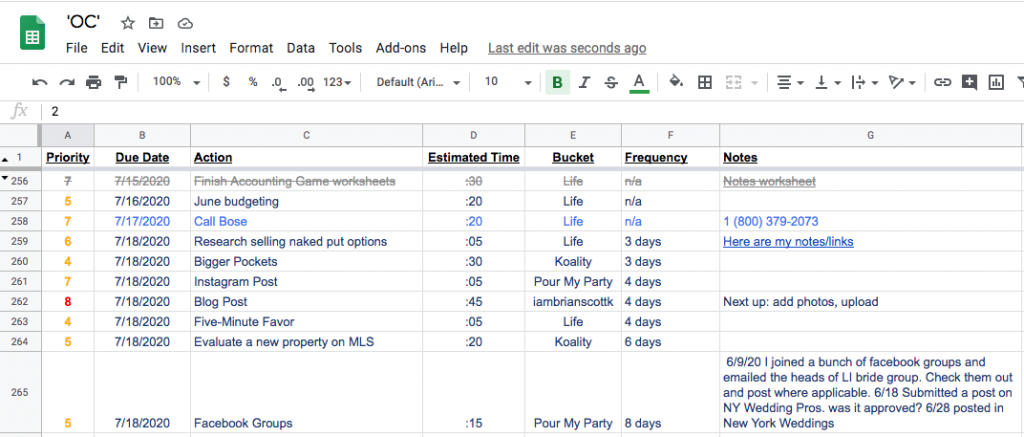Organization, motivation and accountability are the three keys to success in business and life. Let’s dig into how these three attributes, when combined through a detailed calendar, can help you realize your dreams.
Through quarantine, social distance, and working from home, that illusory free time we’ve been dreaming of forever has finally arrived at our front door.
It’s time to get off our collective asses. It’s time to succeed.
How will we do that? Well, “A journey of a thousand miles begins with a single step”, right?

A journey of a thousand miles begins with a single step.
Laozi
What if I told you that all you need is “One Calendar” to begin your journey towards success in business and life?
Sound easy enough?
We’re now a full five months into quarantine, and many are starting to get restless. Sure, we’ve begun seeing friends and family again, but mostly in socially-distant outdoor scenarios. Many states have begun reopening, but given the uptick in infections, it seems safe to say that we are not “getting back to normal” anytime soon. Crowded subways and packed stadiums still seem like a far-off pipe dream even now in August.
You’ve long ago finished watching Tiger King (that was “so April”), are halfway done with a sophomore run-through of The Sopranos or Lost, and you’re beginning to get stir-crazy.

Even if you’re full-steam-ahead with working from home, based on logistics alone, you’re now staring down a ton of free time that had previously been occupied by commuting, restauranting, and personal grooming.
Binge-watching is less and less fulfilling each day, and you’re starting to feel like you need a hobby.
You dust off that old screenplay. Maybe now you’ll finish it.
That brilliant idea for an invention you had three years ago. Maybe now you’ll build it.
Frustrated with systemic racism, you went to a protest, and donated to a few of those great charities you read about. But you want to do more. Maybe now, you’ll act on it.
You think you’re ready to take that first step, but the journey seems soo long and soo arduous.
Maybe you should just curl up on the couch and watch another episode.
No! This time is different. Carpe diem!
Let’s dig in.
Step 1: Plan the Work
First thing’s first. If you want to find success in business and life, you must make the commitment.
Tell yourself what it is you’re going to do. Not what you think you might, maybe, possibly want to do. No.
Tell yourself what you will do. Unequivocally. Next, say it out loud. Close the door if you want. Blast some music. Leave the house. Get in your car. Wherever you need to go to feel comfortable. Then, use your vocal cords. Make the affirmation to yourself.
Jack Canfield, motivational speaker and famed co-author of the Chicken Soup for the Soul series says “Daily affirmations are to the mind what exercise is to the body. Repeating affirmations helps to reprogram the unconscious mind for success.”

Daily affirmations are to the mind what exercise is to the body. Repeating affirmations helps to reprogram the unconscious mind for success.
Jack Canfield
Then tell someone who you care about and trust who will hold you accountable. I’ll get into accountability in more detail shortly, but suffice to say, as humans we are hardwired to avoid feelings of shame and guilt. By telling someone who you love and trust that you’re going to do something, you force yourself to feel bad about letting them down if you veer off your path.
The Backstory
Almost exactly a year ago, I decided that I wanted to begin investing in real estate. I knew absolutely nothing about the topic and committed to myself that I was going to learn. I enrolled in an amazing course from Paula Pant and began the journey.
But… I had a problem.
I paid the tuition, gained access to the course, watched a few videos, took some quizzes, but I was falling behind. Sure there was the “Turtle Power” option to go at your own pace, but the suggested tempo was one module a week for 10 weeks.
After the first few weeks, my wife asked me how I was doing:
Good, I said.
What have you learned?, she asked.
“Cap Rate”, I replied.
After I explained what that was, she asked, what else?
That’s about it, so far.
In 3 weeks, you only learned one subject? WE just spent $1,000 on this course, and YOU promised to commit to this thing, but you don’t seem to be putting any real effort into it.
You’re right.
That’s when my wife, a perpetual learner with more degrees than a protractor, showed me her calendar. For someone as seemingly disorganized as her, I was thoroughly impressed with how much detail was on there.
A “pen and ink” kinda gal, she pulled out some printer paper, made a grid 7 boxes wide by 4 boxes tall, and over the course of the next few minutes created for me what would become the template for my “OC”, the One Calendar; my North Star, that I now look at every single day.
My version is now digitized and on Google Sheets, but the premise is the same. The power of the OC lies in its simplicity and the ease in which it forces you to get organized, stay motivated and hold yourself accountable. (Notice a pattern yet?)

For those of you in the real estate, entrepreneurial, or FI communities, you probably know Bigger Pockets. And if you know Bigger Pockets, you probably know Brandon Turner’s Intention Journal.
Similar in premise to the Intention Journal, the OC is your canvas on which you paint your goals and game-plan. The key differences, however, are the expansive micro-goals and step-by-step processes you use to reach those goals, all of which are duly recorded on the OC.
Step 2: Work the Plan
So what goes on the OC?
All of the goals you would put on your Intention Journal, plus all of the in-the-weeds steps needed to get there. No task is too small or too large for the OC.
Nowadays for me, everything that needs to get done goes in this document.
It began with the real estate course, but it’s grown to include things like “pay quarterly estimated taxes”, “get mother’s day gift”, “write journal entry”, “work on blog post”, “call Vendor X”, “Do a Five Minute Favor”.
An inherently forgetful and procrastinatory person, anything important that I might forget or I might perpetually put off until “tomorrow” now goes on the OC.
Three Types of Entries on the OC:
Three “types” of entries go on the OC—Goals, Tasks and Projects.
Goals:
Goals are broad and ambitious. The perfect example of a goal on my OC was “Buy first rental property”. I set that for exactly one year from the date I finished my real estate course.
Tasks:
Tasks are on the opposite end of the spectrum—small, but important minutiae that gets crossed off upon completion (an important detail that I will revisit momentarily.)
“Read NY Times article on the future of Manhattan Real Estate” (hyperlinked to that article) is a task example. “Pay taxes” is another one. “File LLC registration forms for Pour My Party” is another.
The key component of a “task” is that once it’s done, I never have to think about it again. Tasks get crossed off (via “strikethrough” text formatting) and color-changed from black or blue text to gray, but never deleted.
Nothing gets totally deleted as you’ll never know when you want to go back and reference an old task or the date on which it was completed.
Projects:
The most common entry on The OC, however, is the “project”. The key difference between a task and a project is that projects typically don’t get crossed out or completed; they simply get “rescheduled” for some future date.
Examples of projects could be “Follow up with Partner X”, “Update balance sheet”, “Pay credit card bill”, “Watch Pinterest tutorial videos”, “Post on Instagram.”
Wherever possible, I prefer creating projects over tasks for a few key reasons. Let me explain.
While it is true that in certain respects, OC “projects” do get completed and can eventually get crossed off the list, I typically prefer to “reschedule” that project for some date far off in the future.
Detailed examples of OC “Projects”:
Let’s dig into this one a bit to provide some context.
- “Make contact with Prospect X”: My school of thought is that the “timing” of your outreach is just as important as the message itself with regards to whether or not someone responds.
Long story short, an unanswered email doesn’t mean that your prospect doesn’t want to hear about your offering at all; just not right now. As such, the “project” of establishing contact (and then following up) with any prospect is something that might get rescheduled for 2 weeks out after the first call/email, 4 weeks out after the second, 6 weeks after the third, etc.
With this method, I am never totally writing them off, but I am devoting less and less attention to them the longer time passes without a response.
As such, “prospect outreach” = “project” and not a “task”
- Five-Minute Favors: I wrote a whole separate post about why I love these, which you should definitely check out.
Without getting into all that detail here, I often use “five-minute favor” as shorthand for “reach out to an old contact offering to help them instead of asking for them to help me”.
If I spend the effort to rekindle a relationship with an old contact, why am I going to simply let that wither on the vine all over again? If that contact responds, but we don’t have anything immediate and actionable to explore, I’ll take some notes in the OC about what we discussed and reschedule that project for a year into the future. If they don’t respond at all, I cross them off and move on.
- Read Bigger Pockets: Instead of creating a single “task” tied to a specific article, I prefer to create a more general “project” that’s “Read Bigger Pockets for 30 minutes” or “Read 3-5 articles in the BP Forums”. This holds me accountable for staying current in an area that’s important to my business. This can be perpetually rescheduled for as often or infrequently as makes sense for you.
Elements of the OC:
Now that we have discussed the three types of entries, let’s look at the format of the OC.
Priority:
Scaled from 1 to 10 with 1 being the least important and 10 being the most. When I pop open the OC, I try to work through the highest priority items first and go down the priority list. This way, if I can only get to a few items on my list in any given day, at least I get to the more important ones first.
Working on your highest priority items first helps you stay “productive” instead of just being “busy”. If certain low-priority items keep missing the cut from your daily workload, consider delegating them to someone else or removing them entirely.
I color-code 1 to 3 in green, 4 to 7 in yellow and, and 8 to 10 in red for an easy visual cue.
You can easily swap out the 1 to 10 scale for 1 to 5—whatever works best for you.
Due Date:
Self-explanatory for sure, but note that for projects, this is the date that perpetually gets “rescheduled” to that TBD future date that keeps them in the queue.
Action:
Simply stating what it is that needs to be done
Estimated Time:
This one is not essential, but by estimating how much time something will take, I know what I might be able to get done in the 15 minutes I have before a conference call, for example.
Bucket:
This is where I denote if this entry is tied to one of my business projects (ie, Pour My Party or Koality Holdings), this blog, or simply “life”.
Frequency:
For recurring projects, like “Email a new craft distiller”, I note here the frequency in which it gets done—every 3 days in this example. I don’t have the bandwidth to work on everything every single day, so this helps space things out a bit.
Notes:
Here’s where I track progress, include email addresses/phone numbers, or even hyperlink to urls or other Google Docs being referenced.
Color coding:
One last element to point out is a blue/black color code. Black items can be taken care of anytime during the day, but blue items can only be handled M-F during business hours. If I need to call the Office of Taxation for the City of Detroit to see if there are any outstanding taxes on a property I might buy, I’d code this blue so I know it needs to get done between 9a and 5p.
Conclusion: Does “The OC” help you find success in business and life?
Since the beginning of covid-quarantine, I’ve purchased my first rental property; brought on six new spirits partners, three new event planners, and two caterers for Pour My Party; wrote four extensive articles for this blog; gotten one of those articles published on AllBusiness; consulted for a stealth startup in the virtual events space; reconnected with two dozen old contacts; planned my father’s surprise 70th birthday; transformed our extra bedroom into a home-office; designed and built a new WordPress site; taught myself options trading, Pinterest strategy, and Facebook Ad Manager; read 8 books, started regular journaling, and exercised 6 days a week every week; all while working my 9 to 5 job.
Is this all a #humblebrag? Maybe.
But there’s a point here, obviously. If you can get organized, stay motivated, and hold yourself accountable, success will soon follow. The One Calendar is the tangible manifestation of that. If I can use it to find success in business and life, what can you do with it?
Enter your email address below to receive the OC template right in your inbox.
No more excuses.


Leave a Reply